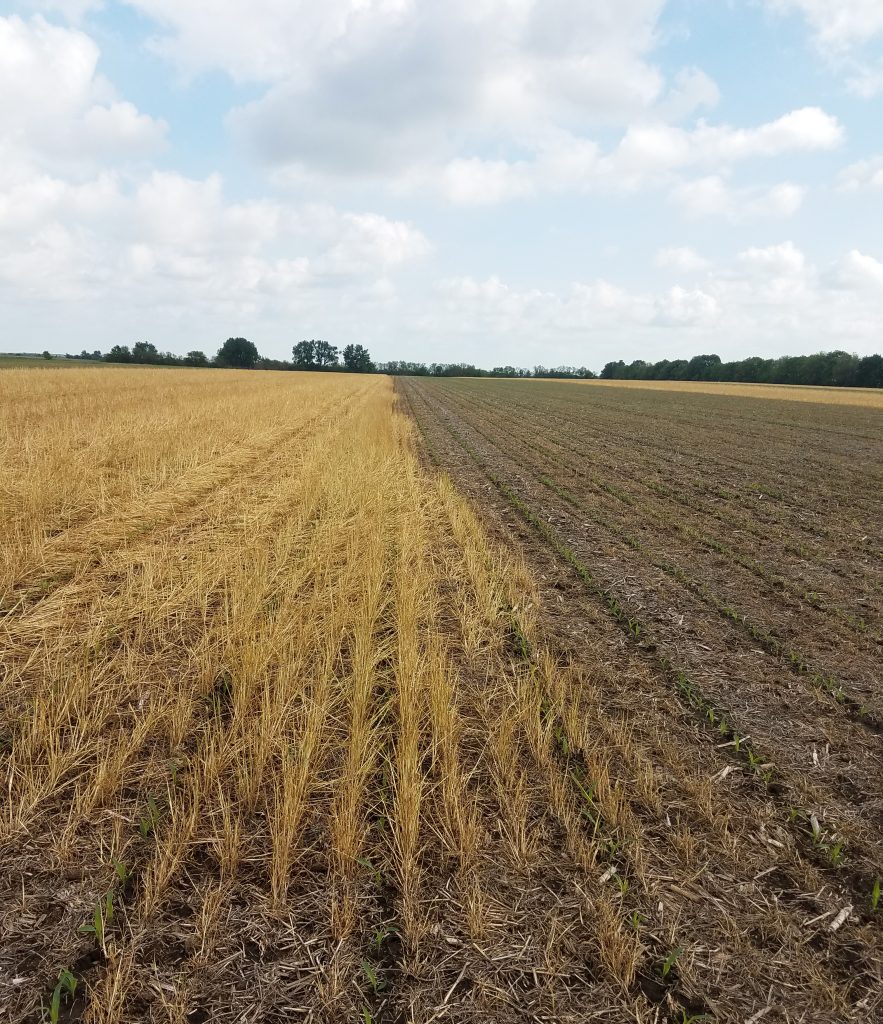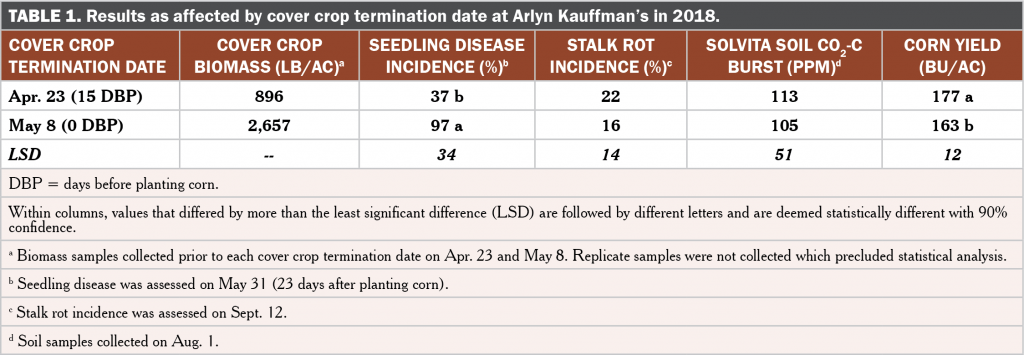In a Nutshell:
- Delaying cover crop termination date in the spring can result in more growth (and attendant environmental benefits) but could also result in corn yield drag.
- In this experimental trial, Arlyn Kauffman compared two cereal rye cover crop termination dates: 15 and 0 days before planting corn (same day as planting corn).
Key Findings
- Delaying cover crop termination until the day of corn planting resulted in three times as much aboveground cover crop biomass.
- Corn seedlings showed nearly three times as much disease when the cover crop was terminated on the same day as corn planting.
- Compared to when the cover crop was terminated 15 days before planting corn, delaying cover crop termination until the day of corn planting resulted in a yield drag of 14 bu/ac.
Background

At left, cereal rye cover crop that was terminated on the same day as planting corn (May 8). At right¸ cereal rye crop that was terminated 14 days before planting corn (Apr. 26). Photo taken May 21, 2018.
Recent on-farm research by PFI cooperators Dick Sloan and Tim Sieren has tested the effects of “planting green”: planting corn within two days of terminating a cover crop. In three of the four trials involved in those studies, planting green resulted in corn yields reduced by 3–12% compared to when the cover crop was terminated 14–21 days before planting corn.[1,2] Research by scientists in North Carolina[3] and Iowa[4] has documented similar corn yield reductions from terminating a cover crop within a few days of planting the corn. Even with these past results in mind, Arlyn Kauffman wanted to try planting corn into green cereal rye himself to better inform his long-term cover crop practices.
Objective: Determine the effect of termination date of a cereal rye cover crop on corn seedling disease and yield.
Methods
This experiment was conducted by Arlyn Kauffman near Weldon in Clarke County. Treatments involved a cereal rye cover crop terminated 15 and 0 days before planting (DBP) corn. The termination date treatments were replicated three times and arranged in a randomized complete block design.
Kauffman seeded the cereal rye cover crop on Oct. 15, 2017 at a rate of 70 lb/ac using a drill. The first cover crop termination date occurred on Apr. 23, 2018 (15 DBP) with an application of glyphosate (48 oz/ac) and 2,4-D (8 oz/ac). The second termination date occurred on May 8 (0 DBP; same day as planting corn) with an application of glyphosate (32 oz/ac). Kauffman collected biomass samples of the cover crop just prior to either termination date that were dried and weighed. Corn was planted in both treatments on May 8 at a rate of 30,500 seeds/ac. Nitrogen fertilizer was applied at a rate of 71 lb N/ac as UAN at the time of planting. Pest control consisted of Stalwart (herbicide) applied at 96 oz/ac and Lorsban (insecticide) applied at 4 oz/ac on May 9. On May 31, Dr. Alison Robertson and Jyotsna Acharya from the ISU Department of Plant Physiology and Microbiology collected corn seedling samples from each strip and assessed them for incidence of disease (root rot). A side-dress N fertilizer application of 50 lb N/ac as urea occurred on June 13. Kauffman collected soil samples to a depth of 6 in. on Aug. 1 and sent to Ag Source Laboratories (Ellsworth, IA) for a soil health assessment using the Solvita assay. Dr. Robertson’s team returned on Sept. 12 to collect corn stalk samples to assess incidence of rot. Corn was harvested individually from each strip on Sept. 25.
Data were analyzed using JMP Pro 13 (SAS Institute Inc., Cary, NC) statistical software. Means separations are reported using a t-test at the 90% confidence level.
Results and Discussion
Cover crop growth
Kauffman collected samples of cover crop aboveground biomass at the time of both termination dates. The cereal rye cover crop terminated 0 DBP (May 8, day of corn planting) produced nearly three times as much biomass as the cereal rye terminated 15 DBP (Table 1).
Seedling disease and stalk rot incidence
Alison Robertson and Jyotsna Acharya, researchers from the Plant Pathology and Microbiology Department at ISU, collected corn seedling samples on May 31 (corn was at growth stage V4). Nearly all of the corn seedlings sampled from the 0 DBP treatment showed signs of seedling disease (Table 1). These ISU researchers found very similar results in recent lab and field studies. Terminating a cover crop within one day of corn planting resulted in 96% of seedlings showing signs of disease on average.[4] Incidence of stalk rot, assessed in mid-September, was not affected by cover crop termination date (Table 1).
Soil health
Kauffman collected soil samples from the strips on Aug. 1 and sent them to AgSource Laboratories for a soil health assay using the Solvita C2-C burst test. This test measures the amount of CO2-C that is respired from the soil sample over a 24-hr period – the more CO2-C that is respired from the soil, the more biological activity in the soil (e.g., the healthier the soil). Cover crop termination date did not affect the amount of CO2-C respired from the soil (Table 1). Though delaying cover crop termination until corn planting (0 DBP) resulted in much more cover crop biomass produced, this did not result in a measured improvement in soil health.
Corn yield
Corn yields were reduced by 14 bu/ac when the cover crop was terminated 0 DBP compared to 15 DBP (Table 1). Regardless of cover crop termination date, Kauffman’s corn yields were greater than the three-year Clarke County average of 160 bu/ac.[5] Kauffman’s results echo those of previous on-farm research by Dick Sloan and Tim Sieren. From trials in 2016 and 2017, Sloan and Sieren saw corn yields reduced by 5–21 bu/ac compared to where they terminated cover crops at least two weeks prior to planting the corn.[1,2] The lower yields in the 0 DBP treatment at Kauffman’s corresponds to where Dr. Robertson’s team observed more seedling disease (Table 1). “We were surprised to see a yield difference because there was no visible difference (from the road) between the treatments at any time during the season,” Kauffman said. “But we still had significant yield drag, although not as bad as we have seen in the past when planting corn into green rye.” Kauffman credits the 71 lb N/ac applied near the furrow at planting with preventing worse yield declines. “We are used to seeing yellowing in corn seedlings and juvenile stages when planted into green rye, but this year we saw none and we’re attributing that to the N provided right beside the furrow at planting.”
Conclusions and Next Steps
In this experiment, Arlyn Kauffman compared terminating a cereal rye cover crop on the same day he planted corn with terminating the cover crop about two weeks before planting corn. Much like the experiences of previous PFI cooperators who tested “planting green,” Kauffman noted a significant corn yield penalty. Terminating the cover crop on the same day he planted corn also resulted in nearly three times as much seedling disease observed. “This trial really helped to clarify things for us. I am starting to believe Alison Robertson’s ‘green bridge’ theory on corn yield drag,” Kauffman said. He’s referring to previous findings by Robertson and Acharya, the ISU researchers who sampled his farm, that showed similar trends with respect to corn seedling disease and corn yield when planting green. The “green bridge” refers to the cereal rye cover crop harboring pathogens that can affect corn seedlings. To avoid this, the ISU researchers recommend farmers wait 10 to 14 days between cereal rye cover crop termination and corn planting.[4]
Appendix – Weather Conditions

FIGURE A1. Mean monthly temperature and rainfall for the period Oct. 1, 2017 through Sept. 30, 2018 and the long-term averages at the Osceola weather station,[6] the nearest weather station to Arlyn Kauffman’s farm (about 16 miles away).
References
- Gailans, S. and D. Sloan. 2016. Cover Crop Termination Date Ahead of Corn. Practical Farmers of Iowa Cooperators’ Program. https://practicalfarmers.org/wp-content/uploads/2018/10/16.FC_.CC.Cover_Crop_Termination_Date_Corn.pdf (accessed March 2019).
- Gailans, S., D. Sloan and T. Sieren. 2017. N Fertilizer Strategies for Corn Following Cover Crop. Practical Farmers of Iowa Cooperators’ Program. https://practicalfarmers.org/wp-content/uploads/2018/10/17.FC_.CC.N-fert-strategies-for-corn-after-cover.compressed.pdf (accessed March 2019).
- Vaughan, J.D. and G.K. Evanylo. 1998. Corn response to cover crop species, spring desiccation time, and residue management. Agronomy Journal. 90:536–544. https://www.researchgate.net/profile/Gregory_Evanylo/publication/237976342_Corn_Response_to_Cover_Crop_Species_Spring_Desiccation_Time_and_Residue_Management/links/548b57550cf225bf669f884d/Corn-Response-to-Cover-Crop-Species-Spring-Desiccation-Time-and-Re (accessed March 2019).
- Acharya, J., M.G. Bakker, T.B. Moorman, T.C. Kaspar, A.W. Lenssen and A.E. Robertson. 2016. Time Interval Between Cover Crop Termination and Planting Influences Corn Seedling Disease, Plant Growth, and Yield. Plant Disease. 101:591–600. https://apsjournals.apsnet.org/doi/pdfplus/10.1094/PDIS-07-16-0975-RE (accessed March 2019).
- US Department of Agriculture-National Agricultural Statistics Service. Quick stats. USDA-National Agricultural Statistics Service. https://quickstats.nass.usda.gov/ (accessed March 2019).
- Iowa Environmental Mesonet. 2019. Climodat Reports. Iowa State University. http://mesonet.agron.iastate.edu/climodat/ (accessed March 2019).


